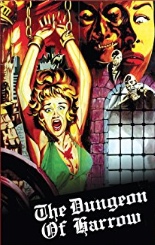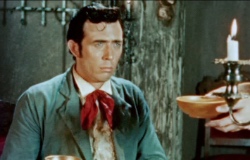
 Before a lengthy career drawing many a Charlton Comics title, Pat Boyette tried his hand at filmmaking. Although he technically succeeded, in that he directed three movies in two years, he failed spectacularly. His best-known film, The Dungeon of Harrow, is harrowing only in trying to sit through it.
Before a lengthy career drawing many a Charlton Comics title, Pat Boyette tried his hand at filmmaking. Although he technically succeeded, in that he directed three movies in two years, he failed spectacularly. His best-known film, The Dungeon of Harrow, is harrowing only in trying to sit through it.
Looking not unlike Nicolas Cage dipped in Clairol Natural Instincts for Men, the weaker-than-milquetoast Russ Harvey overwhelmingly underwhelms in his starring role as Aaron Fallon, a trust-fund wimp who is one of only two shipwreck survivors stranded on the island of Count Lorente de Sade (William McNulty), our obvious madman whose requisite Gothic castle predictably includes an array of guest accommodations (read: torture chambers).
 When I tell you that the shipwreck is rendered via toy boat, or crashes of lightning achieved through the flickering of light, I do so not to encourage viewing, but to testify against it. The extra spaces inserted randomly in the opening titles should be considered a bellwether — one warning of “incomprehensible dreck ahead.”
When I tell you that the shipwreck is rendered via toy boat, or crashes of lightning achieved through the flickering of light, I do so not to encourage viewing, but to testify against it. The extra spaces inserted randomly in the opening titles should be considered a bellwether — one warning of “incomprehensible dreck ahead.”
As director, co-writer, editor, composer and supporting player, Boyette was aiming for something in the snazzy style of Roger Corman’s Edgar Allan Poe adaptations. The result is The Terror, but on Medicaid assistance. Shot in San Antonio, The Dungeon of Harrow proves that precious few Texas-lensed terrors can be a Chain Saw Massacre. This is one of those public-domain titles at which even the public domain took a gander, turned up its nose, made a shooing gesture and said, “Nah, I’m good.” —Rod Lott

It’s as if Manos, Hands of Fate had been transported to the early 19th Century